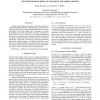Free Online Productivity Tools
i2Speak
i2Symbol
i2OCR
iTex2Img
iWeb2Print
iWeb2Shot
i2Type
iPdf2Split
iPdf2Merge
i2Bopomofo
i2Arabic
i2Style
i2Image
i2PDF
iLatex2Rtf
Sci2ools
ICIP
2007
IEEE
2007
IEEE
Fourier Domain Display Color Filter Array Design
In digital image display devices, data are typically presented via a spatial subsampling procedure implemented as a color filter array, a physical construction whereby each light emitting element controls the intensity level of only a single color. In this paper, we examine the problem of color filter array design with respect to spatial resolution and human vision; in doing so we quantify the fundamental limitations of existing designs by explicitly considering the spectral wavelength representation induced by the choice of array pattern, and propose a framework for designing and analyzing alternative patterns that minimize aliasing. An empirical evaluations on standard color test image confirms our theoretical results, and indicates the potential of these patterns to significantly increase spatial resolution while at the same time improving color image fidelity.
Color filter Array | ICIP 2007 | Image Processing | Spatial Resolution | Spatial Subsampling Procedure |
| Added | 03 Jun 2010 |
| Updated | 03 Jun 2010 |
| Type | Conference |
| Year | 2007 |
| Where | ICIP |
| Authors | Keigo Hirakawa, Patrick J. Wolfe |
Comments (0)

